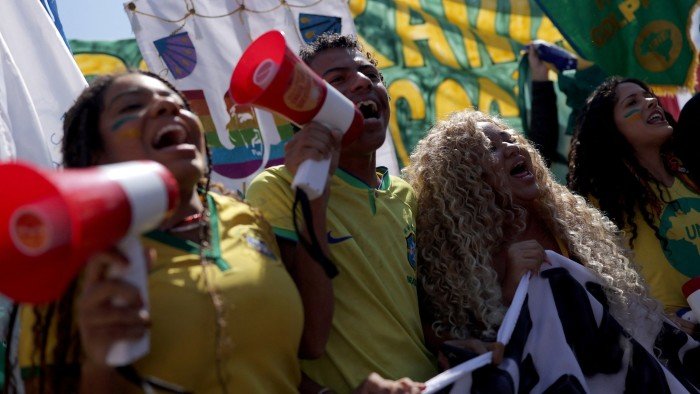Unlock the White House Watch newsletter for free
Your guide to what Trump’s second term means for Washington, business and the world
Donald Trump portrays the tariffs he has ordered on dozens of US trading partners as a way to rebalance a global trading system that he claims is skewed against America. What is striking, however, is how some of the harshest new measures reflect blatantly political aims — shaped by presidential whim.
Take Canada, a major ally, whose headline tariff rate was raised to 35 per cent, even if a carve-out for goods under the USMCA trade pact softens the impact. The White House blamed Canada for failing to co-operate in curbing the “ongoing flood of fentanyl and other illicit drugs” — though there is no such flood — and retaliating against earlier tariffs. But Trump cited Canada’s plans to recognise a Palestinian state as making it “very hard” to reach a trade deal.
Then there is India, hit with a 25 per cent rate Indian officials had expressed optimism about reaching a deal. The US president criticised Indian trade barriers — but also threatened an additional penalty and rebuked Prime Minister Narendra Modi’s government for “buying Russian oil and weapons”. Trump’s stance also appears to reflect his dislike of India’s membership of the Brics bloc. During a summit of the 11 emerging economies last month he threatened an additional 10 per cent tariff on any countries aligning themselves with the Brics’ “anti-American policies”.
South Africa, another Brics member, was hit with a hefty 30 per cent tariff. Its government is ensnared in an argument with the White House over false allegations of a “white genocide” — a big talking point among Trump’s Maga base.
No country has been singled out for such nakedly political treatment as the Brics summit host — Brazil, slapped with the highest headline tariff rate, at 50 per cent, plus other punitive measures, even though the US runs a trade surplus with Brazil. Trump explicitly linked the tariffs to Brazil’s supreme court case against his ally, the far-right former president Jair Bolsonaro, on charges of plotting a coup after losing a re-election bid to Luiz Inácio Lula da Silva in 2022 — which has obvious parallels with the US president’s own attempts to overturn the result of the 2020 US election.
Even before any court verdict, Trump has called the trial a “witch-hunt”. His administration has banned eight top Brazilian justices from the US for allegedly instituting a “persecution and censorship complex”. Washington raised the pressure last week by imposing financial sanctions on Alexandre de Moraes, the judge overseeing Bolsonaro’s trial, under the Global Magnitsky Act — supposed to be reserved for grave human rights violators.
Brazil’s supreme court has also annoyed Trump by becoming a global pacesetter for social media regulation, forcing platforms to remove content deemed hate speech, anti-democratic or an incitement to violence. While some of the court’s specific takedown orders appear overzealous, they hardly fit Trump’s description of “tyrannically and arbitrarily coercing United States companies to censor political speech”.
Using trade measures for political purposes against a fellow democracy is particularly unfortunate when it comes to Brazil. As one of the world’s more closed economies, it would benefit from opening up its large goods and services markets and exposing cosseted national players to competition. Yet by tying tariffs to Bolsonaro’s trial, the US president has made discussion of trade liberalisation much harder.
The Brazil case also highlights how far Trump is stretching the president’s powers to impose temporary tariffs, which are supposed to be limited to a sudden import surge, specific national security threats, or unfair foreign trade practices. As long as Congress or US courts fail to rein him in, the gradual strain of his levies on the US economy and financial markets appear to be the only constraints on the president using tariffs to reshape global trade — and pursue his own vendettas.

